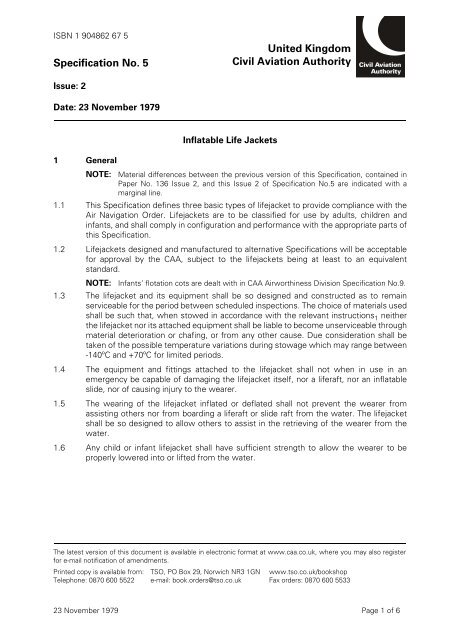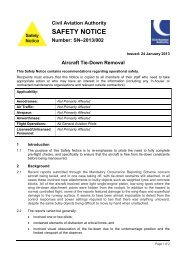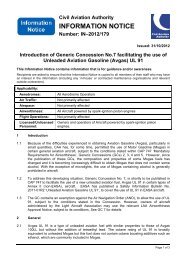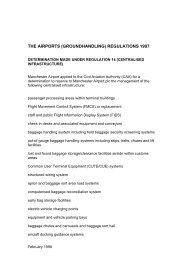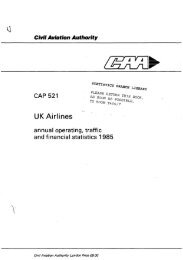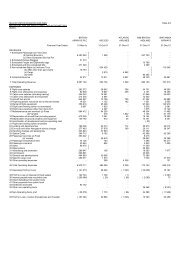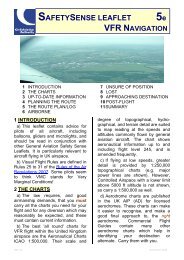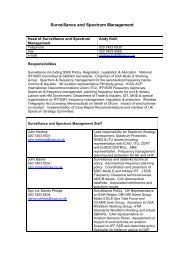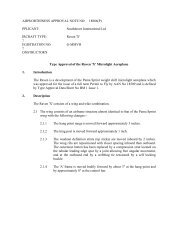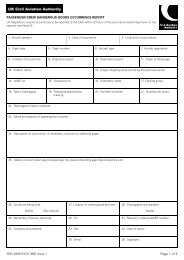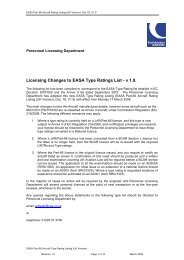CAA Spec 05 - Inflatable Life Jackets - Civil Aviation Authority
CAA Spec 05 - Inflatable Life Jackets - Civil Aviation Authority
CAA Spec 05 - Inflatable Life Jackets - Civil Aviation Authority
Create successful ePaper yourself
Turn your PDF publications into a flip-book with our unique Google optimized e-Paper software.
ISBN 1 904862 67 5<br />
<strong>Spec</strong>ification No. 5<br />
Issue: 2<br />
Date: 23 November 1979<br />
<strong>Inflatable</strong> <strong>Life</strong> <strong>Jackets</strong><br />
United Kingdom<br />
<strong>Civil</strong> <strong>Aviation</strong> <strong>Authority</strong><br />
1 General<br />
NOTE: Material differences between the previous version of this <strong>Spec</strong>ification, contained in<br />
Paper No. 136 Issue 2, and this Issue 2 of <strong>Spec</strong>ification No.5 are indicated with a<br />
marginal line.<br />
1.1 This <strong>Spec</strong>ification defines three basic types of lifejacket to provide compliance with the<br />
Air Navigation Order. <strong>Life</strong>jackets are to be classified for use by adults, children and<br />
infants, and shall comply in configuration and performance with the appropriate parts of<br />
this <strong>Spec</strong>ification.<br />
1.2 <strong>Life</strong>jackets designed and manufactured to alternative <strong>Spec</strong>ifications will be acceptable<br />
for approval by the <strong>CAA</strong>, subject to the lifejackets being at least to an equivalent<br />
standard.<br />
NOTE: Infants’ flotation cots are dealt with in <strong>CAA</strong> Airworthiness Division <strong>Spec</strong>ification No.9.<br />
1.3 The lifejacket and its equipment shall be so designed and constructed as to remain<br />
serviceable for the period between scheduled inspections. The choice of materials used<br />
shall be such that, when stowed in accordance with the relevant instructions1 neither<br />
the lifejacket nor its attached equipment shall be liable to become unserviceable through<br />
material deterioration or chafing, or from any other cause. Due consideration shall be<br />
taken of the possible temperature variations during stowage which may range between<br />
-140ºC and +70ºC for limited periods.<br />
1.4 The equipment and fittings attached to the lifejacket shall not when in use in an<br />
emergency be capable of damaging the lifejacket itself, nor a liferaft, nor an inflatable<br />
slide, nor of causing injury to the wearer.<br />
1.5 The wearing of the lifejacket inflated or deflated shall not prevent the wearer from<br />
assisting others nor from boarding a liferaft or slide raft from the water. The lifejacket<br />
shall be so designed to allow others to assist in the retrieving of the wearer from the<br />
water.<br />
1.6 Any child or infant lifejacket shall have sufficient strength to allow the wearer to be<br />
properly lowered into or lifted from the water.<br />
The latest version of this document is available in electronic format at www.caa.co.uk, where you may also register<br />
for e-mail notification of amendments.<br />
Printed copy is available from: TSO, PO Box 29, Norwich NR3 1GN www.tso.co.uk/bookshop<br />
Telephone: 0870 600 5522 e-mail: book.orders@tso.co.uk Fax orders: 0870 600 5533<br />
23 November 1979 Page 1 of 6
UK <strong>Civil</strong> <strong>Aviation</strong> <strong>Authority</strong> <strong>Spec</strong>ification No. 5<br />
2 Buoyancy and Flotation Attitude<br />
2.1 The minimum total buoyancy applicable to the particular type of user of the lifejacket<br />
shall be as follows:-<br />
USER NOMINAL WEIGHT<br />
MIN. TOTAL BUOYANCY IN<br />
FRESH WATER AT 20°C<br />
ADULT 41 kg (90 lb.) and over 16 kg (35 lb.)<br />
CHILD Over 16 kg (35 lb.) and up to 41 kg<br />
(90 lb.)<br />
11.5 kg (25 lb.)<br />
INFANT Up to 16 kg (35 lb.) 9 kg (20 lb.)<br />
NOTE: If may be possible to achieve the above three categories with a single design of<br />
lifejacket.<br />
2.1.1 The total buoyancy of the lifejacket shall be determined by using the method of the<br />
volume displacement of fresh water by the lifejacket when totally submerged.<br />
2.2 The inflated lifejacket shall support the wearer in the water in a stable attitude which<br />
shall be taken to be when the trunk of the body is inclined backwards from the vertical<br />
at an angle of between 30º and 60º. In such an attitude the lifejacket shall provide<br />
support to the wearer’s head such that the mouth is held clear of the water even if the<br />
wearer is unconscious.<br />
2.3 Starting with the support attitude referred to in 2.2, the lifejacket shall allow the wearer<br />
to manoeuvre in the water.<br />
2.4 When donned and inflated correctly, the lifejacket shall be capable of righting an<br />
unconscious wearer to the flotation attitude referred to in 2.2, within 5 seconds and<br />
retaining the wearer in this attitude.<br />
2.5 The lifejacket shall not unduly restrict the wearer’ a field of vision and should permit the<br />
wearer an adequate movement of the head.<br />
3 Inflation System<br />
3.1 General<br />
3.1.1 The lifejacket shall have two separate means of inflation, the primary means being a<br />
mechanically-initiated stored gas system and the secondary means a standby oral<br />
inflation system capable of repeated use. The required buoyancy shall be obtainable by<br />
either method.<br />
3.1.2 A manually-operated means of releasing the pressure in the lifejacket is required and<br />
shall be of a type capable of repeated use. Protection shall be provided against<br />
inadvertent deflation.<br />
3.1.3 After inflation by either method, it shall be possible to deflate the lifejacket and then to<br />
re-inflate it by using the standby method. The standby inflation method shall be readily<br />
accessible, simple and obvious in operation and it shall be impossible for any valve<br />
which may be used to be inadvertently left open. It shall be possible to “top up” the<br />
lifejacket orally whilst in use and without loss of inflation pressure.<br />
3.1.4 If the lifejacket is of the reversible type, the requirements of this <strong>Spec</strong>ification also apply<br />
with the lifejacket worn in the reverse sense.<br />
23 November 1979 Page 2 of 6
UK <strong>Civil</strong> <strong>Aviation</strong> <strong>Authority</strong> <strong>Spec</strong>ification No. 5<br />
3.2 Stored Gas System<br />
3.1.1 Location of the actuating means of this type of system shall be such that it can be<br />
operated by either hand, in or out of the water. The method of releasing the stored gas<br />
into the lifejacket shall be obvious; however, suitable marking shall be provided to advise<br />
the user.<br />
3.1.2 The amount of stored gas provided shall be capable of inflating the lifejacket to achieve<br />
the correct buoyancy as specified in 21 within 10 seconds of release into the lifejacket.<br />
3.1.3 Adequate protection shall be provided to guard against any inadvertent initiation of an<br />
inflation, e.g. by vibration when stowed, when its wearer is climbing through an<br />
emergency exit or when it is dropped from a height of l.5 m (5 ft.).<br />
3.2 Oral Inflation System<br />
The oral inflation device provided shall be fitted with a non-return valve and be<br />
positioned such that it can readily be used in and out of the water. After use, the device<br />
shall return to a position such that it will not produce facial injuries during a jump into the<br />
water as specified in 7.1.3. The non-return valve shall open initially at a maximum air<br />
pressure of 25 kN/m 2 (10 ins. water) applied at the mouthpiece.<br />
4 Donning and Adjustment<br />
4.1 The correct method of donning the lifejacket shall be reasonably self-evident to<br />
untrained passengers. The lifejacket shall be made to fit securely throughout its range<br />
of adjustment in all likely conditions of use and size of wearer. So far as possible, any<br />
adjustment necessary to make the lifejacket fit securely shall be made automatically<br />
when being donned. The wearer shall be able to make any re-adjustment without undue<br />
risk of the lifejacket slipping off. The lifejacket should be capable of being removed from<br />
the valise or container and donned by an adult passenger, seated in an aircraft, within<br />
15 seconds unassisted, with a safety belt fastened.<br />
4.2 It shall be practicable for a trained crew member to place upon another adult, child or<br />
infant, the appropriate lifejacket within 30 seconds unassisted.<br />
4.3 It shall be practicable for an adult to place a lifejacket on an incapacitated adult in or out<br />
of the water, at least to an extent to allow the latter to be provided with sufficient<br />
flotation such as to hold the wearer’s head clear of the water.<br />
4.4 Subsequent to proper donning, inadvertent release or loosening of the lifejacket such<br />
that its flotation characteristics are unacceptably altered, shall be prevented.<br />
4.5 The shape of the lifejacket shall not restrict breathing, nor unnecessarily channel water<br />
or spray into the wearer’s face, when in the water.<br />
5 Attached Equipment<br />
5.1 Any equipment attached to the lifejacket shall be of such design and location that it will<br />
not interfere with the donning, wearing, operation and performance of the lifejacket in<br />
any way, nor reduce its life.<br />
5.2 Each lifejacket shall be fitted with a light source, having an output nominally equivalent<br />
to at least 1.0 Lumen, for a continuous period of 12 hours even when immersed in<br />
water. Any bulb-protecting lens, when clean, shall allow a light distribution consistent<br />
with maximum conspicuity at a minimum light transmission factor of 90%. The location<br />
of the light source shall be such that maximum practical conspicuity is achieved with the<br />
appropriate lifejacket worn in the normal manner by an adult, child or infant when in the<br />
water. For increased conspicuity and enhancement of the effectiveness of directed light<br />
sources, e.g. searchlights, it is recommended that patches of retro-reflective material be<br />
affixed to the surfaces of the lifejacket.<br />
23 November 1979 Page 3 of 6
UK <strong>Civil</strong> <strong>Aviation</strong> <strong>Authority</strong> <strong>Spec</strong>ification No. 5<br />
5.3 Where a whistle is required it shall be a one-piece type and attached to the lifejacket by<br />
a cord of sufficient length to facilitate use. In the event of the whistle being immersed,<br />
it shall be capable of being effectively operated within 5 seconds of its removal from the<br />
water.<br />
5.4 Any other attached equipment shall be demonstrated to the <strong>CAA</strong> as having no adverse<br />
effects on the operation, life and performance of the lifejacket.<br />
6 Spray Hoods<br />
6.1 Where a spray hood is provided, the following design considerations shall be taken into<br />
account.<br />
6.2 The wearer shall be able to deploy the hood easily when wearing the lifejacket (inflated<br />
or deflated) in or out of the water.<br />
6.3 The spray hood shall be permanently attached to the lifejacket in such a fashion that it<br />
can be easily re-stowed when not in use, without reducing the performance of the basic<br />
lifejacket. The hood will not be considered suitable if it can in any way retain water.<br />
6.4 The angles of vision shall not be unduly restricted, and the ability to swim and<br />
manoeuvre shall not be impaired by life jackets fitted with a hood.<br />
6.5 The lifejacket’s light source shall not be masked by the presence of the spray hood.<br />
6.6 The materials used in the hood’s construction shall be compatible with those of the<br />
lifejacket and shall in no way be able to cause damage to the buoyancy chambers or<br />
fabric of the lifejacket or liferaft.<br />
7 Practical Tests<br />
7.1 A lifejacket of the type for which approval is sought shall be tested in both calm and<br />
disturbed water (e.g. a swimming pool and in choppy sea or simulated choppy sea<br />
conditions). The Manufacturer’s evaluation of the lifejacket, shall be agreed with the<br />
<strong>CAA</strong> and shall at least include the following tests or demonstrations.<br />
7.1.1 Flotation Test The clearance of a wearer’s face above the water shall be checked for<br />
a conscious person and the corresponding clearance shall be assessed, assuming the<br />
person to be unconscious as required in 2.2 and 2.4.<br />
7.1.2 Swimming Test The practicability of self-propulsion in the lifejacket shall be proved.<br />
A swimming test shall be made with the lifejacket deflated and a test to show the<br />
practicability of self-propulsion with the lifejacket inflated shall also be made as referred<br />
to in 2.3.<br />
7.1.3 3m (10 ft.) Jump Test Jumps shall be made from a height of 3m (10 feet) in the<br />
attention position into the water to demonstrate that there is no danger of injury to the<br />
wearer and no significant displacement of or damage to the lifejacket. This test shall be<br />
made with the lifejacket both inflated and deflated when worn by subjects of varying<br />
stature.<br />
7.1.4 Strength Pressure Test The lifejacket shall have proof and ultimate factors of not less<br />
than 3 and 5 respectively on the pressure at which it is designed to be inflated by the<br />
primary means, at a stabilised ambient temperature of +45ºC, and in no case shall the<br />
proof and ultimate pressures be less than 14 kN/m2 (2 lbf/in2 ) and 23 kN/m2 (3.3 lbf/in2 )<br />
respectively.<br />
7.1.5 Buoyancy The lifejacket shall retain buoyancy after use of the primary inflation system<br />
to such an extent that after a period of 12 hours the requirements of 2.2 and 2.4 can be<br />
met.<br />
23 November 1979 Page 4 of 6
UK <strong>Civil</strong> <strong>Aviation</strong> <strong>Authority</strong> <strong>Spec</strong>ification No. 5<br />
8 Materials and Processes<br />
8.1 All materials used shall be to a specification which controls the suitability of the material<br />
for its intended application including storage.<br />
8.2 Leather shall not be used.<br />
8.3 The choice of materials and protective treatment shall be such that during the period<br />
between inspections, corrosion or deterioration will not render the lifejacket<br />
unserviceable.<br />
8.4 The lifejacket, packed ready for stowage, shall not support combustion, nor shall it be<br />
likely to be rendered unserviceable by inadvertent contact with a lighted match or<br />
cigarette. The valise or container material shall meet the requirements of <strong>CAA</strong><br />
<strong>Spec</strong>ification No.8, Issue 2 dated 24 th September 1973 - Flame Resistance Testing for<br />
Aircraft Interior Materials.<br />
8.5 The magnetic effect of the lifejacket shall not exceed one degree deflection of an aircraft<br />
compass placed at a distance of 300 mm (1 ft.).<br />
9 Colour, Operational Markings and Packaging<br />
9.1 If crew lifejackets are different from passenger lifejackets then, both lifejackets and<br />
valises shall be marked accordingly.<br />
9.2 The predominant colour of the lifejacket shall be an approved International Rescue<br />
colour, as specified in British Standards Institution <strong>Spec</strong>ification No. BS.381C or<br />
acceptable equivalent. Instructions for donning and operation shall be readable to the<br />
wearer of the lifejacket taking into account the reversible lifejacket.<br />
9.3 The lifejacket’s donning and operating instructions shall be bold and readable in low<br />
levels of illumination and shall be kept to a minimum with the purpose of achieving<br />
speed of correct operation and minimum confusion.<br />
9.4 The valise or container in which the lifejacket is to be kept whilst on board the aircraft<br />
shall be approved as part of the lifejacket’s general assembly.<br />
9.5 The valise or container shall clearly be marked to the effect that a lifejacket is contained<br />
therein. The method of opening the package shall be rapid and obvious, (without the<br />
use, of excessive physical force).<br />
10 Marking<br />
10.1 Each detachable part of the lifejacket shall where practicable be marked with:<br />
a) The manufacturer’s approved inspection stamp;<br />
b) The part number;<br />
c) Date of manufacture or batch record.<br />
NOTE: Where marking is not practicable alternative means should be agreed with the <strong>CAA</strong>.<br />
10.2 The lifejacket assembly shall be marked with:<br />
a) The lifejacket model designation;<br />
b) The manufacturer’s name and address;<br />
c) Date of manufacture;<br />
d) Serial Number;<br />
e) Date at which next service and overhaul are due;<br />
f) <strong>Life</strong>jacket classification, i.e. adult, child or infant, or combination thereof.<br />
23 November 1979 Page 5 of 6
UK <strong>Civil</strong> <strong>Aviation</strong> <strong>Authority</strong> <strong>Spec</strong>ification No. 5<br />
10.3 The charged inflation cylinder shall be marked with its total weight and the weight of<br />
charge.<br />
10.4 The markings prescribed in 10.1, 10.2 and 10.3 shall be made such that they remain<br />
legible.<br />
23 November 1979 Page 6 of 6


